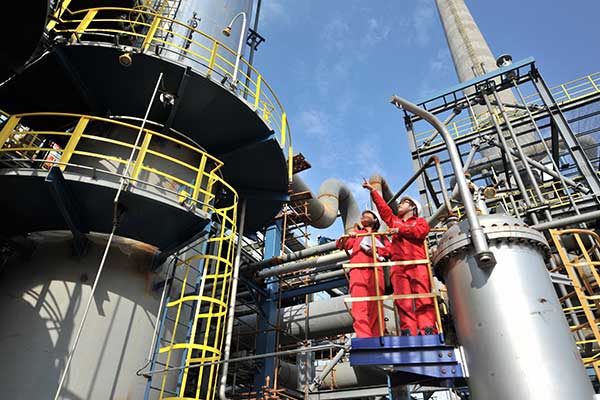
Sinopec employees check natural gas equipment in Guangyuan, Sichuan province, in June.[Photo by Hu Qingming/For China Daily]
Despite oil demand rising 5.5 percent year-on-year to 11.77 million barrels per day in 2017, oil consumption, including gasoline and diesel, is expected to fall gradually over the next five to seven years, as China focuses more on energy efficiency and quality.
Li Li, energy research director at ICIS China, said despite the fact that peak consumption of oil is yet to come and gasoline and diesel are still dominant in the transportation sector, consumption growth has been slowing in recent years.
She said gasoline and diesel demand will slow with downward pressure in five to seven years, due to growth in alternative and renewable fuels, expansion of vehicle sharing, increasing ethanol-based gasoline supply, as well as expansion of high-speed rail networks.
China’s shift from quantity to quality, improved energy efficiency and tight environmental control will further cap oil consumption, she said.
According to S&P Global Platts China Oil Analytics, apparent oil demand is expected to rise by 500,000 barrels per day in 2018, equivalent to year-on-year growth of 4.2 percent.
This is also in accordance with forecasts from Sinopec’s and China National Petroleum Corp’s research institutes, which expect oil demand growth will slow from more than 5 percent in 2017 to over 4 percent in 2018, based on the assumption that China’s GDP will grow 6.7 percent in 2018, slower than 6.9 percent in 2017.
Wang Lu, Asia-Pacific oil and gas analyst at Bloomberg Intelligence, said the slowing growth rate is mostly due to alternative fuel vehicles, which has in turn dented China’s transport oil demand.
“China’s oil demand will drop and gasoline consumption will weaken in the 2018-20 period, due to surging sales of alternative-fuel vehicles,” she said.
“The government’s pollution fight to tighten fuel-efficiency standards is also dampening transport oil demand, while higher oil prices enhance the economics of natural-gas vehicles.”
Wang said gasoline demand, which already fell 0.02 percent from a year earlier in June, weakened by strong electric vehicle sales, is likely to moderate to 2 percent this year, due to a sales surge of alternative-fuel vehicles and fuel-efficiency gains, while bike-sharing is denting short-distance driving as well.
Bloomberg Intelligence estimates that growth in China’s gasoline demand may slump in 2019-2020 on the country’s mandate for 10 percent ethanol blend by the end of the decade.
On the other hand, China’s diesel demand, which fell 4.5 percent in June and 2.7 percent in the first six months of 2018 compared with a year earlier due to the slowdown in industrial output growth, is also likely to remain weak as the nation’s economy shifts toward consumption and services and away from heavy industry, she said.
Wang said increasing numbers of electric vehicles running on the roads as well as heavy-duty trucks powered by liquefied natural gas also weaken the demand for diesel.
Production of large LNG trucks broke records in 2017 with a total of 96,000 vehicles produced, compared with 19,600 in 2016. Insiders estimate demand for natural gas powered trucks is likely to continue to rise this year, especially in the logistics, postal services and public transportation sectors.
Several ports in China, including those in Hebei and Shandong provinces and Tianjin Port, have already replaced diesel trucks with railways to carry coal, according to local environmental authorities.
Diesel is the largest component of China’s major oil products, so any slowdown in its use will dent demand for oil products, Wang explained.
China raised the retail prices of gasoline and diesel in early August, with retail prices going up by 70 yuan ($10.2) per metric ton for the two types of refined oil products, according to the National Development and Reform Commission.
Major Chinese oil companies, including CNPC, China Petrochemical and China National Offshore Oil, are asked to ensure a stable supply and pricing.
The commission said it would closely monitor the effects of the current pricing mechanism and make changes in response to global fluctuations.
